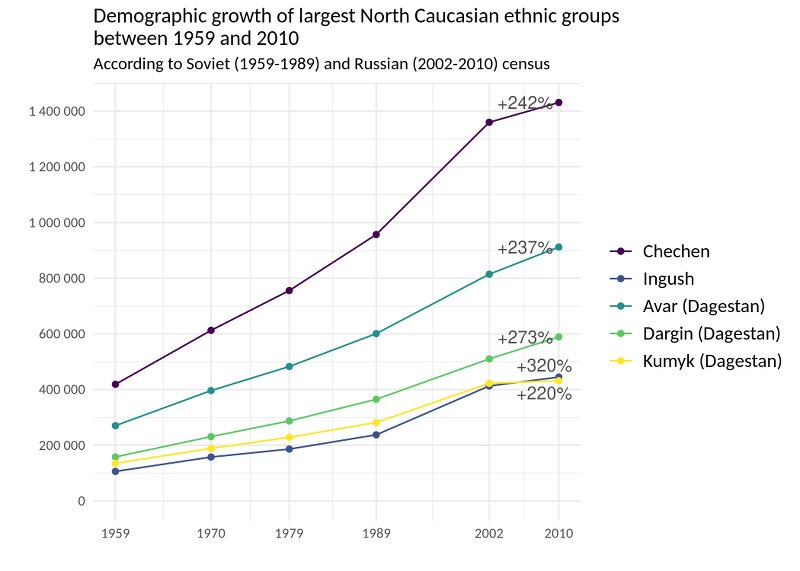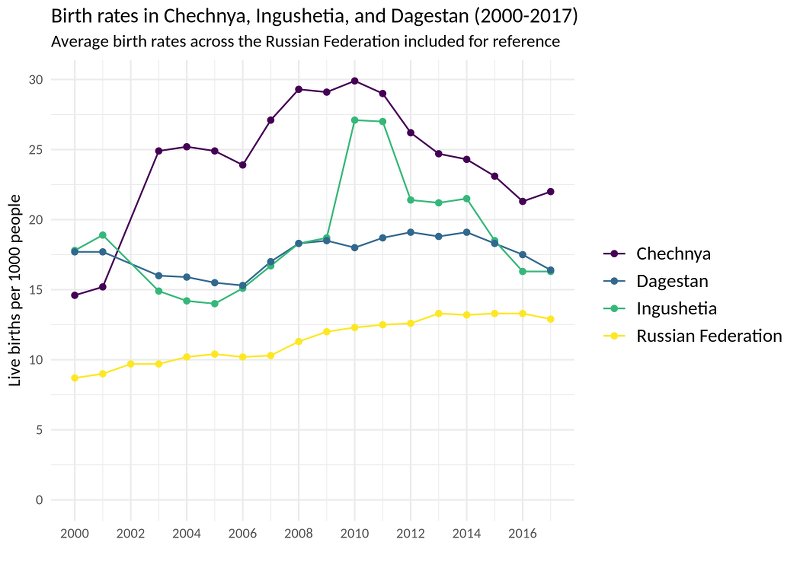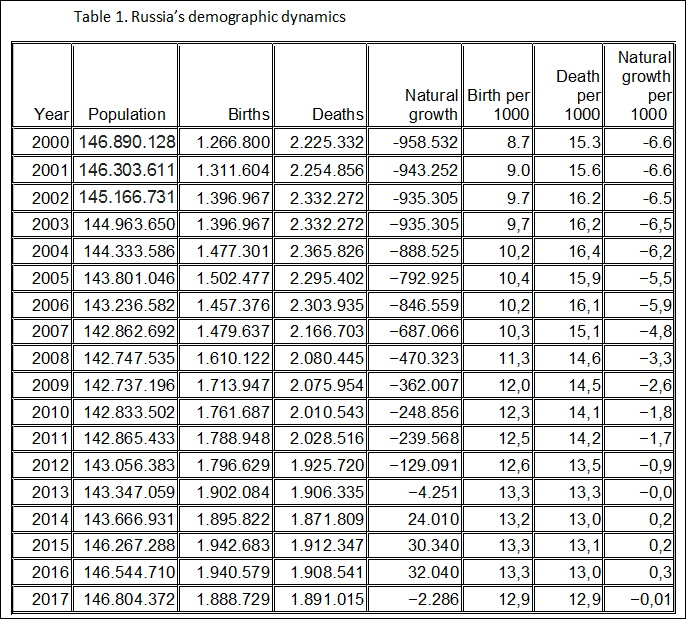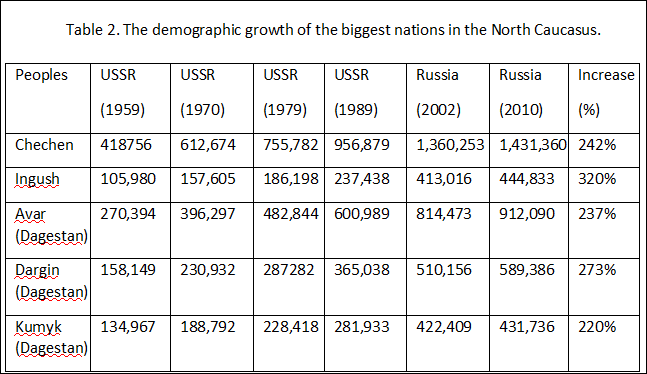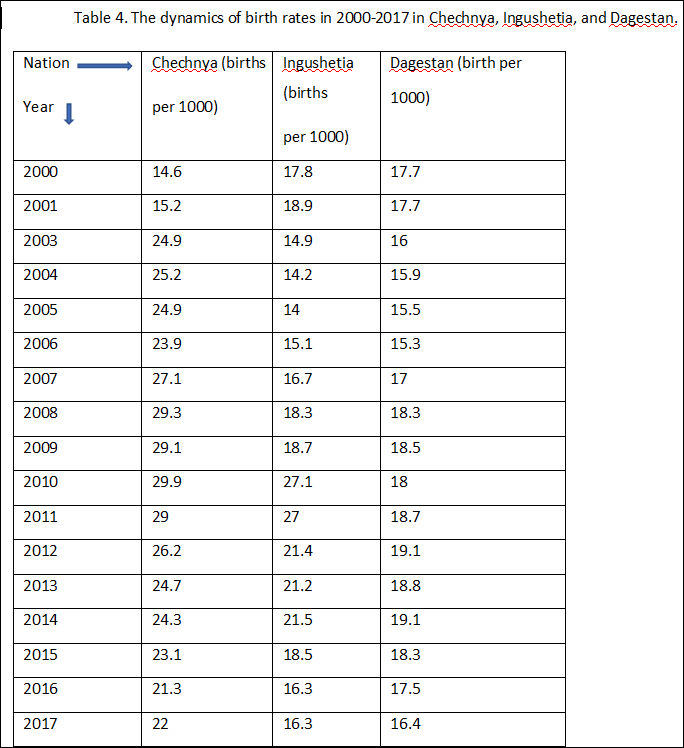Chechen demographic rise: reasons and concerns
Why are birth rates much higher than the Russian average in Chechnya and in other North Caucasus republics?

Chechen-demographic-rise-reasons-and-concerns
Arthimedes/Shutterstock
In the context of the general decline or close to zero increase of the population in Russia (see Table 1), there are few regions that demonstrate the opposite trend. Among these regions are the politically unstable republics of the North Caucasus: Chechnya, Ingushetia, and Dagestan.
Demographic and security rivals
“You have so many children,” –commented a surprised European journalist, who visited Chechnya and stayed in one Chechen family for a night. “You know, it was war…, no electricity…, nothing to do…,” – a host answered jokingly.
Indeed, three or more children per family is the norm in Chechnya, Ingushetia, and Dagestan. As the tables below demonstrate, these three North Caucasian republics are very close rivals in several demographic indicators. Among them are high birth rates, low death rates, and fast natural growth (which does not include migration). The latter factor causes usual concerns of the local administrations, which must ensure for the growing population enough nurseries, schools, playgrounds, stadiums, hospitals, workplaces, etc.
Besides demographic growth, these republics also compete in terms of political instability. In the years of 2008-2010 the online media resource Caucasian Knot, which monitors the situation in the region, even recorded lower numbers of violence related death in Chechnya than in Ingushetia and Dagestan. This prompted analysts to speak about a spill over and spread of the Russo-Chechen war, which was becoming a new Caucasian War.
However, in the beginning of the 2010s, Moscow-supported local governments managed to impose a tighter control over the territory and to bring down the violence. These tough policies resulted in emigration and turned the region into the main provider of fighters from Russia for ISIS.
The recipe – to restrict birth rates
The instability, unfortunately, remained. A huge number of youngsters stayed home, augmenting the numbers of the dissatisfied with inability of the local governments to ensure employment or satisfactory quality of life. These numbers, due to the high birth rates, increase every year, which outlines another concern, this time directly related to the Federal government.
A Russian politician of a dubious reputation and radical views Vladimir Zhirinovsky voiced this concern on Russian TV and through other media several times – high birth rates and the education that children receive in the North Caucasus increase the threat of terrorism. “They raise their children preparing them to die and to kill Russians and Christians… Building new factories and improving the situation with employment will not solve this problem. Because they will always have more children in their families… We need to restrict their birth rates. They have to give birth only to one or two children as the whole humanity. They should be fined for every third child…”
From the Zhirinovky’s speech it could be understood that due to the legacy of the two Russo-Chechen wars of 1994-1996 and 1999-2009, there is a fear that Chechens, Ingush, and Dagestanis are preparing their children for a new war. My research conducted with the Chechens in 2014-2017 targeted this concern by answering the questions: What are the main reasons of the Chechen high birth rates? Is Chechen population growth connected to the recent wars in the region? If yes, what kind of connection it is?
“To survive and to be strong”
The research supported the idea that the link between demography and the existential threat indeed exists. However, “the preparation” for the next war for the Chechens means rather increasing a defensive capacity or the possibility of nation’s survival by strengthening the nation numerically. It was this reason that encouraged the Chechens to opt for larger families even during the war – opposite to what it could be anticipated. Indeed, the average birth rate during the harshest phase of the second war (see Table 2) remained similar to the pre-war situation. The declined intensity of the warfare immediately increased the birth rates almost twice.
The most common explanation of this phenomenon by my interviewees is summarised in the following narrative. “We are constantly at war with Russia. We would have died out if we did not have large families. And this is the main reason. We need large families, so our nation would be strong, so no one would dare to attack us. Furthermore, the bigger the nation is – the better. If we have more people, it means that we have more chances to have good academics, musicians, writers, etc. The bigger the nation, the more chances that it will flourish. I want my nation to be strong and therefore I want many children.”
The connection between the war and birth rates that my interviewees were talking about was not always related to patriotism, as expressed in the previous quote. Some of my respondents would state the reason of passing the family name further. The chances of this possibility in war are at stake. “I was already over thirty when the war began, and I was thinking and talking to myself… And what happens if I die? There won’t be anyone even to pass the family name to… It does not seem right to me.”
The patriotism of the Chechen males was shared by my female respondents too. They were also conscious about the considerably small size of the Chechen nation and wanted it to be stronger. However, the interview with one of Chechen females revealed that other factors play an important role too. The interviewee had a close contact with other Chechen women refugees and transmitted one of the conversations that she had with them. This conversation demonstrated the strong desire to have large families, but it did not clearly articulate the source of such desire. “One woman told me: ‘The social workers here do not want us to give births to children. They try to ‘educate’ us. They suggest us to use contraceptives, but we want to have many children’… I asked her why? And she said to me: ‘What a strange question… Aren’t you a Chechen woman?’
Other reasons
Indeed, other reasons were also mentioned by the Chechen males. The respondents usually enumerated several drivers for the procreation. Among these drivers the most frequently mentioned are: religion, traditions, economic reasons, and rural life style.
The explanations provided can be summarised in a few sentences.
Religion plays an important role, according to many interviewees. Islam (the main religion of Chechens and other North Caucasians), according to them, encourages procreation. God promises to give everyone what belongs to him and therefore you are not concerned much with finances.
The respondents, who mentioned the role of traditions (the second biggest batch), would emphasise that large family for the North Caucasians means better chances in a probable clash for whatever reason. “If you have many sons – you have people to back you up,” – stated many respondents.
Economic reasons were considered by fewer respondents. “The wealthier you are – the more children you can afford,” – was the general attitude of them.
Not so many respondents mentioned the factor of the rural life style. Those who did, claimed that the rural setting favour larger families and that the North Caucasians are mostly rural settlers.
Eventually, only few respondents mentioned a natural drive, as to say that people need to become a parent.
It is important to note, that in the case analysed (the Chechens), all these reasons were a second choice that came after the necessity to survive as a nation. It is questionable if this finding be extended to the neighbouring Ingushetia and Dagestan. Their partial involvement into the violent confrontation with Russia suggests that it might be the case.
Featured articles
- Take part in the survey
Chechen demographic rise: reasons and concerns
Why are birth rates much higher than the Russian average in Chechnya and in other North Caucasus republics?

Chechen-demographic-rise-reasons-and-concerns
Arthimedes/Shutterstock
In the context of the general decline or close to zero increase of the population in Russia (see Table 1), there are few regions that demonstrate the opposite trend. Among these regions are the politically unstable republics of the North Caucasus: Chechnya, Ingushetia, and Dagestan.
Demographic and security rivals
“You have so many children,” –commented a surprised European journalist, who visited Chechnya and stayed in one Chechen family for a night. “You know, it was war…, no electricity…, nothing to do…,” – a host answered jokingly.
Indeed, three or more children per family is the norm in Chechnya, Ingushetia, and Dagestan. As the tables below demonstrate, these three North Caucasian republics are very close rivals in several demographic indicators. Among them are high birth rates, low death rates, and fast natural growth (which does not include migration). The latter factor causes usual concerns of the local administrations, which must ensure for the growing population enough nurseries, schools, playgrounds, stadiums, hospitals, workplaces, etc.
Besides demographic growth, these republics also compete in terms of political instability. In the years of 2008-2010 the online media resource Caucasian Knot, which monitors the situation in the region, even recorded lower numbers of violence related death in Chechnya than in Ingushetia and Dagestan. This prompted analysts to speak about a spill over and spread of the Russo-Chechen war, which was becoming a new Caucasian War.
However, in the beginning of the 2010s, Moscow-supported local governments managed to impose a tighter control over the territory and to bring down the violence. These tough policies resulted in emigration and turned the region into the main provider of fighters from Russia for ISIS.
The recipe – to restrict birth rates
The instability, unfortunately, remained. A huge number of youngsters stayed home, augmenting the numbers of the dissatisfied with inability of the local governments to ensure employment or satisfactory quality of life. These numbers, due to the high birth rates, increase every year, which outlines another concern, this time directly related to the Federal government.
A Russian politician of a dubious reputation and radical views Vladimir Zhirinovsky voiced this concern on Russian TV and through other media several times – high birth rates and the education that children receive in the North Caucasus increase the threat of terrorism. “They raise their children preparing them to die and to kill Russians and Christians… Building new factories and improving the situation with employment will not solve this problem. Because they will always have more children in their families… We need to restrict their birth rates. They have to give birth only to one or two children as the whole humanity. They should be fined for every third child…”
From the Zhirinovky’s speech it could be understood that due to the legacy of the two Russo-Chechen wars of 1994-1996 and 1999-2009, there is a fear that Chechens, Ingush, and Dagestanis are preparing their children for a new war. My research conducted with the Chechens in 2014-2017 targeted this concern by answering the questions: What are the main reasons of the Chechen high birth rates? Is Chechen population growth connected to the recent wars in the region? If yes, what kind of connection it is?
“To survive and to be strong”
The research supported the idea that the link between demography and the existential threat indeed exists. However, “the preparation” for the next war for the Chechens means rather increasing a defensive capacity or the possibility of nation’s survival by strengthening the nation numerically. It was this reason that encouraged the Chechens to opt for larger families even during the war – opposite to what it could be anticipated. Indeed, the average birth rate during the harshest phase of the second war (see Table 2) remained similar to the pre-war situation. The declined intensity of the warfare immediately increased the birth rates almost twice.
The most common explanation of this phenomenon by my interviewees is summarised in the following narrative. “We are constantly at war with Russia. We would have died out if we did not have large families. And this is the main reason. We need large families, so our nation would be strong, so no one would dare to attack us. Furthermore, the bigger the nation is – the better. If we have more people, it means that we have more chances to have good academics, musicians, writers, etc. The bigger the nation, the more chances that it will flourish. I want my nation to be strong and therefore I want many children.”
The connection between the war and birth rates that my interviewees were talking about was not always related to patriotism, as expressed in the previous quote. Some of my respondents would state the reason of passing the family name further. The chances of this possibility in war are at stake. “I was already over thirty when the war began, and I was thinking and talking to myself… And what happens if I die? There won’t be anyone even to pass the family name to… It does not seem right to me.”
The patriotism of the Chechen males was shared by my female respondents too. They were also conscious about the considerably small size of the Chechen nation and wanted it to be stronger. However, the interview with one of Chechen females revealed that other factors play an important role too. The interviewee had a close contact with other Chechen women refugees and transmitted one of the conversations that she had with them. This conversation demonstrated the strong desire to have large families, but it did not clearly articulate the source of such desire. “One woman told me: ‘The social workers here do not want us to give births to children. They try to ‘educate’ us. They suggest us to use contraceptives, but we want to have many children’… I asked her why? And she said to me: ‘What a strange question… Aren’t you a Chechen woman?’
Other reasons
Indeed, other reasons were also mentioned by the Chechen males. The respondents usually enumerated several drivers for the procreation. Among these drivers the most frequently mentioned are: religion, traditions, economic reasons, and rural life style.
The explanations provided can be summarised in a few sentences.
Religion plays an important role, according to many interviewees. Islam (the main religion of Chechens and other North Caucasians), according to them, encourages procreation. God promises to give everyone what belongs to him and therefore you are not concerned much with finances.
The respondents, who mentioned the role of traditions (the second biggest batch), would emphasise that large family for the North Caucasians means better chances in a probable clash for whatever reason. “If you have many sons – you have people to back you up,” – stated many respondents.
Economic reasons were considered by fewer respondents. “The wealthier you are – the more children you can afford,” – was the general attitude of them.
Not so many respondents mentioned the factor of the rural life style. Those who did, claimed that the rural setting favour larger families and that the North Caucasians are mostly rural settlers.
Eventually, only few respondents mentioned a natural drive, as to say that people need to become a parent.
It is important to note, that in the case analysed (the Chechens), all these reasons were a second choice that came after the necessity to survive as a nation. It is questionable if this finding be extended to the neighbouring Ingushetia and Dagestan. Their partial involvement into the violent confrontation with Russia suggests that it might be the case.

